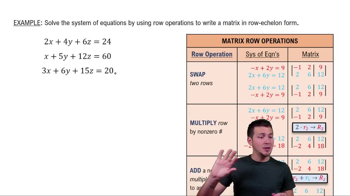Table of contents
- 0. Review of Algebra4h 16m
- 1. Equations & Inequalities3h 18m
- 2. Graphs of Equations43m
- 3. Functions2h 17m
- 4. Polynomial Functions1h 44m
- 5. Rational Functions1h 23m
- 6. Exponential & Logarithmic Functions2h 28m
- 7. Systems of Equations & Matrices4h 6m
- 8. Conic Sections2h 23m
- 9. Sequences, Series, & Induction1h 19m
- 10. Combinatorics & Probability1h 45m
7. Systems of Equations & Matrices
Introduction to Matrices
Problem 9j
Textbook Question
In Exercises 8–11, use Gaussian elimination to find the complete solution to each system, or show that none exists.
 Verified step by step guidance
Verified step by step guidance1
Step 1: Write the system of equations in augmented matrix form. This involves creating a matrix where each row represents an equation and each column represents the coefficients of the variables, with the last column representing the constants on the right side of the equations.
Step 2: Use row operations to transform the matrix into row-echelon form. This means you want to have zeros below the leading coefficients (the first non-zero number from the left, in each row) in each column.
Step 3: Continue using row operations to transform the matrix into reduced row-echelon form. This involves making the leading coefficient in each row equal to 1 and ensuring that all other entries in the column containing a leading 1 are zeros.
Step 4: Interpret the resulting matrix to write the system of equations in its simplified form. This will help you identify the solutions for the variables, if they exist.
Step 5: Determine the complete solution set. If the system is consistent and has a unique solution, write it down. If there are infinitely many solutions, express the solution in terms of free variables. If the system is inconsistent, state that no solution exists.
Recommended similar problem, with video answer:
 Verified Solution
Verified SolutionThis video solution was recommended by our tutors as helpful for the problem above
Video duration:
4mPlay a video:
Was this helpful?
Key Concepts
Here are the essential concepts you must grasp in order to answer the question correctly.
Gaussian Elimination
Gaussian elimination is a method for solving systems of linear equations. It involves transforming the system's augmented matrix into row echelon form using a series of row operations, which include swapping rows, multiplying a row by a non-zero scalar, and adding or subtracting rows. This process simplifies the system, making it easier to find solutions or determine if no solution exists.
Recommended video:
Guided course

Solving Systems of Equations - Elimination
Row Echelon Form
Row echelon form is a specific arrangement of a matrix where all non-zero rows are above any rows of all zeros, and the leading coefficient of each non-zero row (the first non-zero number from the left) is to the right of the leading coefficient of the previous row. This form is crucial in Gaussian elimination as it allows for back substitution to find the values of the variables in a system of equations.
Recommended video:
Guided course

Solving Systems of Equations - Matrices (Row-Echelon Form)
Existence of Solutions
The existence of solutions in a system of linear equations can be determined through the rank of the coefficient matrix and the augmented matrix. If the rank of both matrices is equal and less than or equal to the number of variables, the system has at least one solution. If the ranks differ, the system has no solution, indicating inconsistency among the equations.
Recommended video:

Probability of Non-Mutually Exclusive Events

 4:35m
4:35mWatch next
Master Introduction to Matrices with a bite sized video explanation from Patrick Ford
Start learningRelated Videos
Related Practice










